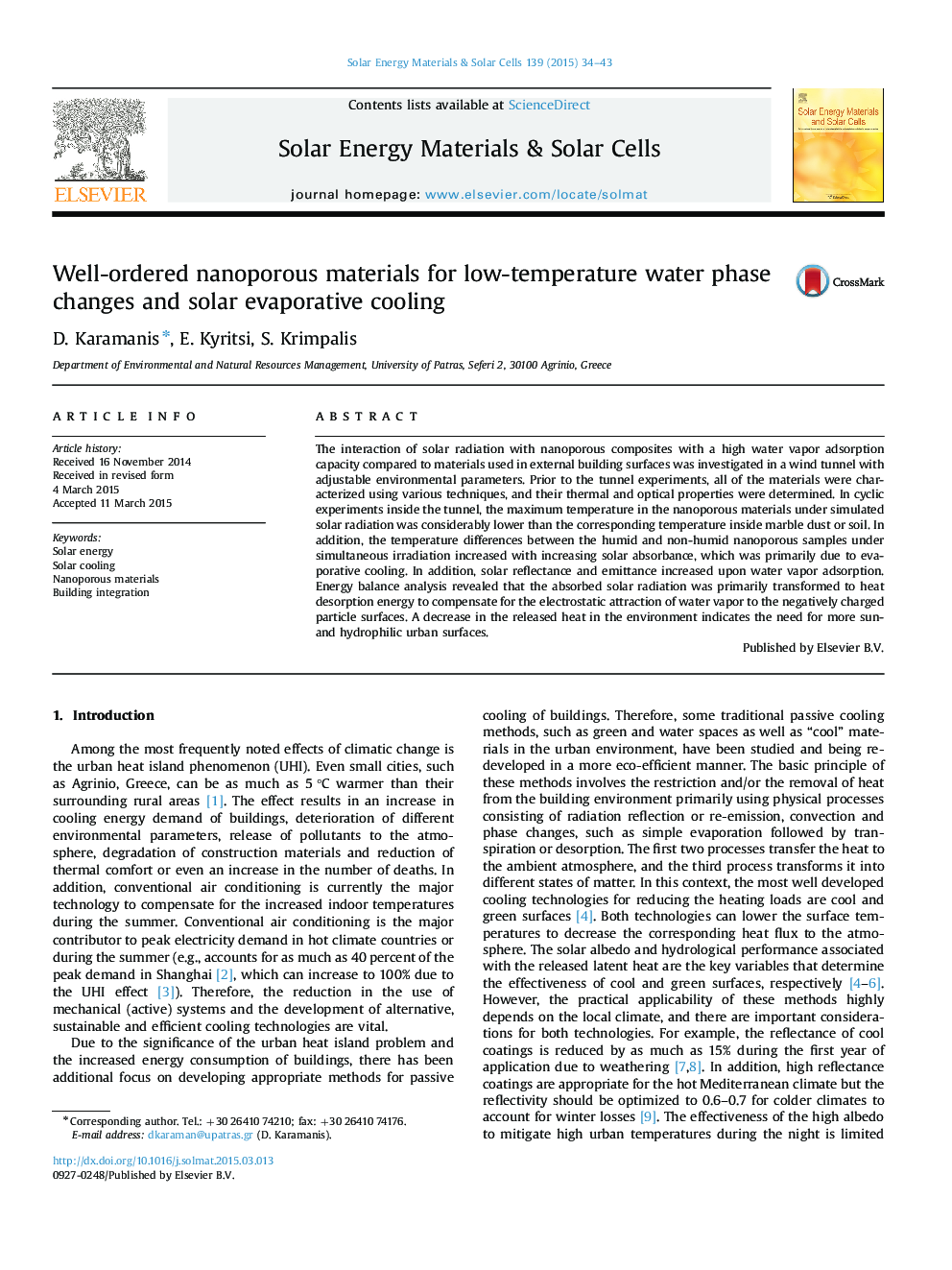| کد مقاله | کد نشریه | سال انتشار | مقاله انگلیسی | نسخه تمام متن |
|---|---|---|---|---|
| 6535186 | 49303 | 2015 | 10 صفحه PDF | دانلود رایگان |
عنوان انگلیسی مقاله ISI
Well-ordered nanoporous materials for low-temperature water phase changes and solar evaporative cooling
ترجمه فارسی عنوان
مواد نانو ذرات مرتب برای تغییرات فاز کم دما و خنک کننده تبخیر خورشید
دانلود مقاله + سفارش ترجمه
دانلود مقاله ISI انگلیسی
رایگان برای ایرانیان
کلمات کلیدی
انرژی خورشیدی، خنک کننده خورشیدی، مواد نانومقیاس، ادغام ساختمان،
ترجمه چکیده
تعامل تابش خورشیدی با کامپوزیت های نانو پودر با ظرفیت جذب بخار آب نسبت به مواد مورد استفاده در سطوح خارجی ساختمان در یک تونل باد با پارامترهای زیست محیطی مورد بررسی قرار گرفت. قبل از آزمایشات تونل، تمام مواد با استفاده از تکنیک های مختلف مشخص شدند و خصوصیات حرارتی و نوری آنها تعیین شد. در آزمایش های چرخه ای درون تونل، حداکثر دما در مواد نانوذرات تحت تابش خورشیدی شبیه شده، به طور قابل توجهی پایین تر از دمای مربوط به گرد و غبار سنگ مرمر یا خاک بود. علاوه بر این، اختلاف دما بین نمونه های نانو پودر مرطوب و غیر مرطوب تحت تابش همزمان با افزایش جذب خورشید افزایش یافته است، که عمدتا به دلیل خنک کننده تبخیری بود. علاوه بر این، بازتاب و خورشید در برابر جذب بخار آب افزایش می یابد. تجزیه و تحلیل توازن انرژی نشان داد که تابش جذب تابش در درجه اول به انرژی گرمازدایی گرما تبدیل شد تا جاذب الکترواستاتیک بخار آب را به سطوح ذرات باردار منفی جبران کند. کاهش گرمای آزاد شده در محیط زیست، نشان دهنده نیاز به سطوح آفتابگردان و هیدروفیلی است.
موضوعات مرتبط
مهندسی و علوم پایه
مهندسی شیمی
کاتالیزور
چکیده انگلیسی
The interaction of solar radiation with nanoporous composites with a high water vapor adsorption capacity compared to materials used in external building surfaces was investigated in a wind tunnel with adjustable environmental parameters. Prior to the tunnel experiments, all of the materials were characterized using various techniques, and their thermal and optical properties were determined. In cyclic experiments inside the tunnel, the maximum temperature in the nanoporous materials under simulated solar radiation was considerably lower than the corresponding temperature inside marble dust or soil. In addition, the temperature differences between the humid and non-humid nanoporous samples under simultaneous irradiation increased with increasing solar absorbance, which was primarily due to evaporative cooling. In addition, solar reflectance and emittance increased upon water vapor adsorption. Energy balance analysis revealed that the absorbed solar radiation was primarily transformed to heat desorption energy to compensate for the electrostatic attraction of water vapor to the negatively charged particle surfaces. A decrease in the released heat in the environment indicates the need for more sun- and hydrophilic urban surfaces.
ناشر
Database: Elsevier - ScienceDirect (ساینس دایرکت)
Journal: Solar Energy Materials and Solar Cells - Volume 139, August 2015, Pages 34-43
Journal: Solar Energy Materials and Solar Cells - Volume 139, August 2015, Pages 34-43
نویسندگان
D. Karamanis, E. Kyritsi, S. Krimpalis,
